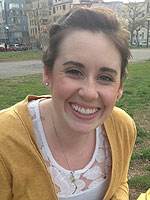In Focus: Christine Gorman
Tell us about your path to Hofstra University.
When I was searching for a graduate program, Hofstra University had the best hands-on creative arts therapy program that I could find in the northeast area. The Creative Arts Therapy program offered me a wide variety of opportunities, classes and internships that I believed would make me the best creative arts therapist I could be. I considered their opportunities to be intriguing and demanding.
How did you decide on your Creative Arts Therapy?
During my undergraduate path to become an art teacher, I realized that I loved teaching art but I also wanted to help people through art. After researching Creative Arts Therapy I realized that the field allowed me to do both of these things that I love in one profession.
What opportunities did you take advantage of at Hofstra?
While I attended Hofstra, I participated in Creative Arts Therapy Club at Hofstra (CATCH), worked as a graduate assistant, attended Hofstra’s Annual Creative Arts Therapy Conferences and, as part of an elective course, was a team member of Camp Resilience which provided art therapy to children from broken homes.
Did you encounter any inspiring faculty at Hofstra?
Margaret Carlock-Russo and Dr. Joan Bloomgarden were each atremendous help and inspiration to me while at Hofstra. They showed me that I can accomplish and achieve any of my goals, art therapy related or not, as long as I work hard and truly love what I am trying to achieve. I also learned different aspects of and insights to the creative arts therapy field that I am very fortunate to have acquired from these faculty members.
Did you find mentors among any of the faculty here?
Yes I did. Both Margaret Carlock-Russo and Dr. Joan Bloomgarden were also mentors to me. Working with these two individuals was exciting and educational. They helped build the creative arts therapist framework in me that I am using today in my professional career.
How did your experience prepare you for your future job search?
My experiences at Hofstra offered many hands on approaches to art therapy, which helped me tremendously during my job search. I specifically chose Hofstra because their classes in art therapy were based on experiential learning. I think my internship at the Helen Keller National Center prepared me mentally for job searching. This internship showed me that I might have to teach myself more about a particular population, language, or setting. That specific experience not only prepared me for future job searching, but showed me that I had the motivation and confidence to enter a setting regardless of my knowledge of that population, setting, or language.
Tell us about your current employment.
Currently, I am a clinical art therapist at a confidential domestic violence shelter. I work with children and adults doing individual art therapy, group art therapy, and domestic violence education classes. Every client has a different story and my role for each client is different. I work with men, women, and children who left a traumatic environment and are trying to start over in a safe environment. We touch on topics about all kinds of abuse, suicidal thoughts and ideation, school, friendships, family, parenting, relaxation techniques and additional support.
Tell us about your internship experiences.
I enjoyed all of my internships. I worked at an outpatient psychiatric center that provided me with hands on experience about mental disorders. Is I mentioned earlier, I also did an internship at Helen Keller National Center. I entered this internship knowing how to spell the alphabet in sign language. I came out of this internship being able to communicate and provide art therapy services with adults who are deaf, blind, and/or deaf-blind in a completely different style or way that I never thought I would be able to do. Both internships were amazing and helped form the creative arts therapist I am today.
What advice would you give to others considering attending Hofstra?
The Creative Arts Therapy program at Hofstra offered several opportunities that I would be unable to receive anywhere else, for example: a dance and movement therapy elective course, family art therapy, Helen Keller National Center, CATCH, and being part of the Camp Resilience team. Hofstra’s program allows students to participate to their full extent while challenging students. The faculty not only teach you, but listen to your ideas and goals. My advice would be to contact the director of the program or a recent graduate and inquire about the program.

